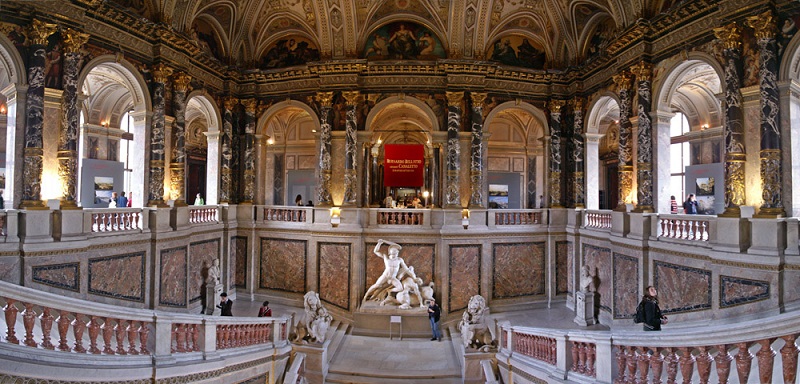Jewish life in Austria dates back to the times of the Roman Empire, originating with the exodus of clusters of Jews from Roman-occupied Israel and peaking in the early 1930’s, when Jews comprised 10% of Vienna’s total population. The ‘Jewish story’ in Austria is defined by the community’s fluctuating political status over the ages, with epochs of equality and prosperity and eras rife with pogroms, deportations and anti-Semitism.
In 1781, Emperor Joseph II issued an ‘Edict of Tolerance’ that eventually led to the emancipation of the Jews and the official sanctioning of an autonomous Jewish religious community in 1849 by Emperor Franz Joseph. The equal rights status facilitated the establishment in 1852 of the Israelitische Kultusgemeinde Wien (IKG)–the Vienna Israelite Community–which serves as the official body that represented Austria’s Jewish communities. This was followed by the 1890 ‘Jewish Law,’ a Habsburg statute that codified the relationship between Jewish congregations and the state on a unified legal basis.
Between 1848 and 1938, Austrian Jewry enjoyed a vibrant Jewish life and contributed much to Vienna’s reputation as a ‘city of intellectuals and artists.’ Much credit is attributed to the significant intellectual and cultural achievements of Jewish luminaries such as Sigmund Freud, Martin Buber, Theodor Herzl, Gustav Mahler, Arthur Schnitzler and many others. In the mid-1930s, the Jewish population numbered some 200,000 (180,000 in Vienna). From 1923 – 1934, 10% of Vienna’s population was Jewish.
Most Austrians enthusiastically welcomed the Anschluss, Germany’s annexation of Austria, in 1938. Austrians joined the Nazi Party and were active in the death camp apparatus in proportionally greater numbers than the Germans. Both Hitler and Adolf Eichmann were Austrian-born. Although many Austrian Jews managed to flee the country after the Anschluss, between 65,000-70,000 were murdered in the Holocaust.
Fifteen thousand Jews live in Austria today, with Vienna the home of the great majority. There are also several smaller communities, none with more than 100 Jews, including Baden, Graz, Innsbruck, Linz, and Salzburg. Present-day Austrian Jewry is primarily composed of Holocaust survivors (and their children), returning Austrian expatriates and refugees from Eastern Europe. In recent years, Austria has offered sanctuary to many Soviet and Iranian Jews. Among the newcomers from the former Soviet Union are a large number of Bukharin and Georgian Jews, who have set up their own religious and cultural center.
The Israelitische Religionsgesellschaft, (the Jewish Religious Association) is the primary representative body of Austrian Jewry. It consists of independent individual communities, each one operating as an umbrella organization within a certain constituency (Graz, Innsbruck, Linz, Salzburg). The Sephardic Federation is also part of the Viennese community and cares for the interests of the Jews of Bukharin and Georgian origin.
Vienna
European Jewish Heritage Tours’ local partner provides an in-depth tour of Vienna, the best place to have a closer look at the marks that centuries of Jewish settlement left in the country′s capital. Today, the Jewish community is concentrated around the Leopoldstadt, the second district, which has tradition as first a ghetto and later a Jewish district. Our guides will show you the Jewish museums in the Dorotheergasse and at the Judenplatz Square in the first district provide more rewarding destinations. You can buy a combined ticket for the two museums and a guided tour to what is probably Vienna′s best-protected building, the Stadttempel, the city’s main synagogue.
The Jüdisches Museum in the Palais Eskeles was founded in 1896, which makes it one of the oldest museum of its kind in the world. Unsurprisingly, though, it was closed by the Nazis in 1938 and not re-opened until 1989 – so the claim for the record age is somewhat dubious. The exhibition is arranged on four floors. On the ground floor, there is a hall that can be used as a lecture hall that has several items of Judaica on display.
In the heart of Medieval Vienna, you will discover the Judenplatz (“Jew′s Square”), which is among the city’s most charming medieval squares. Here you can see two memorials: One for Gottfried Ephraim Lessing, a German writer of the Enlightenment and a celebrated humanist. The other one is the Vienna′s Holocaust Memorial for the Jewish Victims of the Holocaust. Inaugurated in 2000 and designed by the British artist Rachel Witheread, memorial’s placement is no accident Around the corner, you can find a bookshop, an overloaded marble-covered entrance hall that looks somewhat out of place, and the main attraction of the museum: the Café Teitelbaum where many Jewish intellectuals met before the war. However, due to the many international visitors of the museum, it has a distinct international clientele -and an excellent array of newspapers and magazines in German and English.
Since the 15th century, this historic square was the site of the Medieval Jewish ghetto, where Jewish merchants built up quite a community with a synagogue, school and other essentials. A visit to the Judenplatz museum reinforces your understanding about the Medieval Jewish life in Vienna. The final stop is the Stadttempel built in 1826, thus making it the oldest synagogue in Vienna. The Stadttempel was designed by the famous Biedermeier architect Josef Kornhäusl and was the only synagogue to survive the Reichskristallnacht in 1938 – albeit badly damaged.
Naturally, you will want to combine this visit to Vienna with visits to other secular sights that remain compelling reasons to visit the city including the Schonbrun, the “Versailles” of Austria, the Leopold Museum with the finest collection of Austrian art, the magnificent Kunsthistorisches Museum, the Albertina Museum, the Belvedere dedicated to Art Nouveau and the Vienna Secession, and the world-famous Spanish Riding School, to name a few. This is Old World travel at its finest, but with a growing emphasis on younger visitors as well, with outdoor activities such as biking and hiking in and outside the city.



